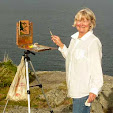Bedroom studio with desk replacing the bed
Desk with Ikea "Alex" drawers and "Billy" bookcase
Cardboard boxes used for organizing things
Cardboard boxes slide away under the shelf
Brush organizers made from paper towel tubes
Shoe box of framing tools
As part of the workshop I taught yesterday on building a regular painting practice on a time budget, we talked about how to minimize the obstacles that get in the way of painting regularly. See the list we discussed at the bottom of this post.
I showed the above photos of my "bedroom" studio. For years I painted in this small bedroom, setting up my still life on a cooler sitting on the double bed which took up most of the floor space! Eventually we needed fewer bedrooms and I was able to move out the bed, install an old desk set up that was headed for the dump, and over time added a couple of Ikea items. But I'm still heavily invested in cardboard, as you can see by the organizers in the photos above. Note that even the taboret is a big cardboard box, and there are others around the room, taped shut, which are used to make stands for still life set ups. The fancy easel is new, for a long time I used either an aluminum Stanrite easel or my plein air box and tripod.
Make it easy to paint - get rid of the obstacles
-->
Minimize set up and clean up
·
Studio in a
bedroom
·
Easel
·
Masterson box
for palette
·
Big flat box
under the bed )to hold your supplies when not in use)
·
Cardboard boxes
are great
·
Ikea is great
·
Ziplock bags are
great
·
Paper towel
tubes are great
·
Glass and
plexiglass make good palettes
Be prepared
·
Decide what
you’re going to paint the day before, anticipation motivates
·
Set up your
still life the day before
·
Crop your photo
the night before
Timing
·
Paint before you
start doing anything else, especially before you get in the car…
·
Tell yourself
you only have to do step x this session
·
Tell yourself
you only have to paint for one hour
Paint!
·
Paint small and
finish in one session – achievement is a great motivator!
Disclaimer: Some of these ideas are mine, but many come from artist friends and teachers. Thanks to everyone for sharing!





























